Even by aviation standards, the Boeing 777X has had a rocky development cycle.
First launched in 2013 and scheduled to enter commercial service in 2020, the B777X has faced numerous delays due to issues with its engines and fuselage, not to mention an “uncommanded pitch event” that will surely raise eyebrows at an FAA already looking sideways at the company following the B737 MAX fiasco. Boeing now expects to receive certification in Q4 2023, which means it could be early 2024 before deliveries begin in earnest.
But innovation is often a messy process, and when it’s all said and done, the B777X promises to be one of the biggest events in commercial aviation history since the debut of the A380.
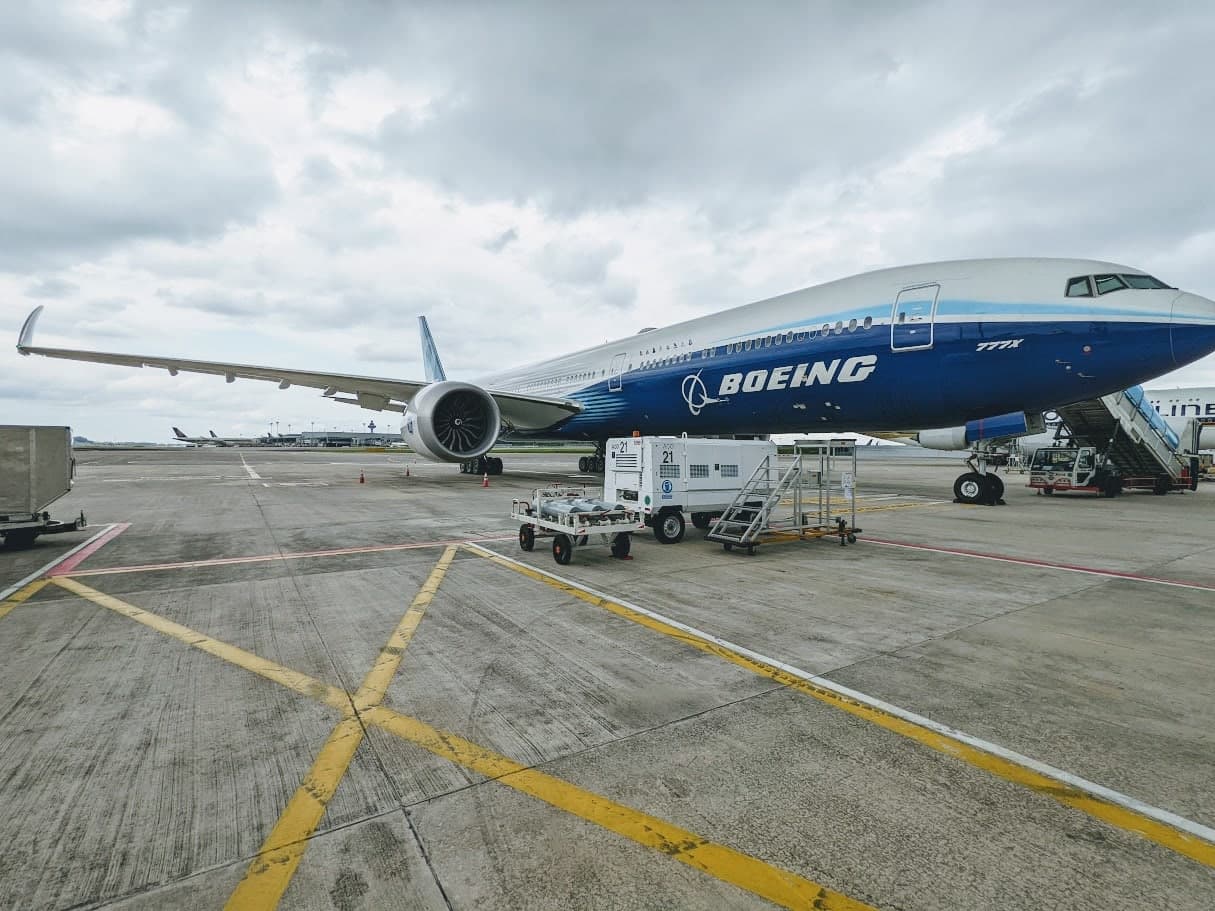
I had the chance to tour a B777-9 test aircraft on the sidelines of the Singapore Airshow, and it’s an exciting vision of what air travel may look like over the next couple of decades.
Boeing 777X: A primer
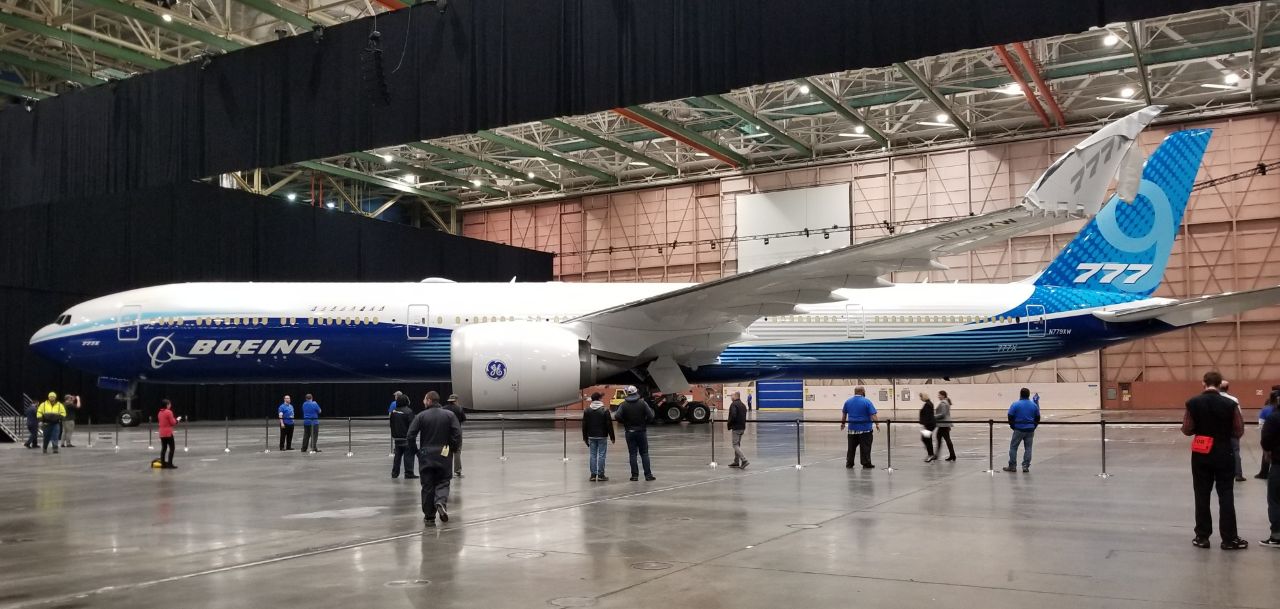
The Boeing 777X is the newest version of the 777, and the largest twin-engined passenger jet ever built, carrying up to 426 passengers in a hypothetical two-class configuration. With giant quadjets like the A380-800 and B747-8 falling out of favour, the B777X will likely be the largest passenger aircraft we see produced in time to come.
From a design perspective, the B777X is a curious beast. Boeing has retained the original aluminium fuselage of the B777, eschewing the lighter composite structure used on the B787 and A350. This means more weight, but is offset by the new engines and wing design.
Wing design? Yes- you can’t talk about the B777X without talking about its unique folding carbon composite wingtips, a first among commercial aircraft.
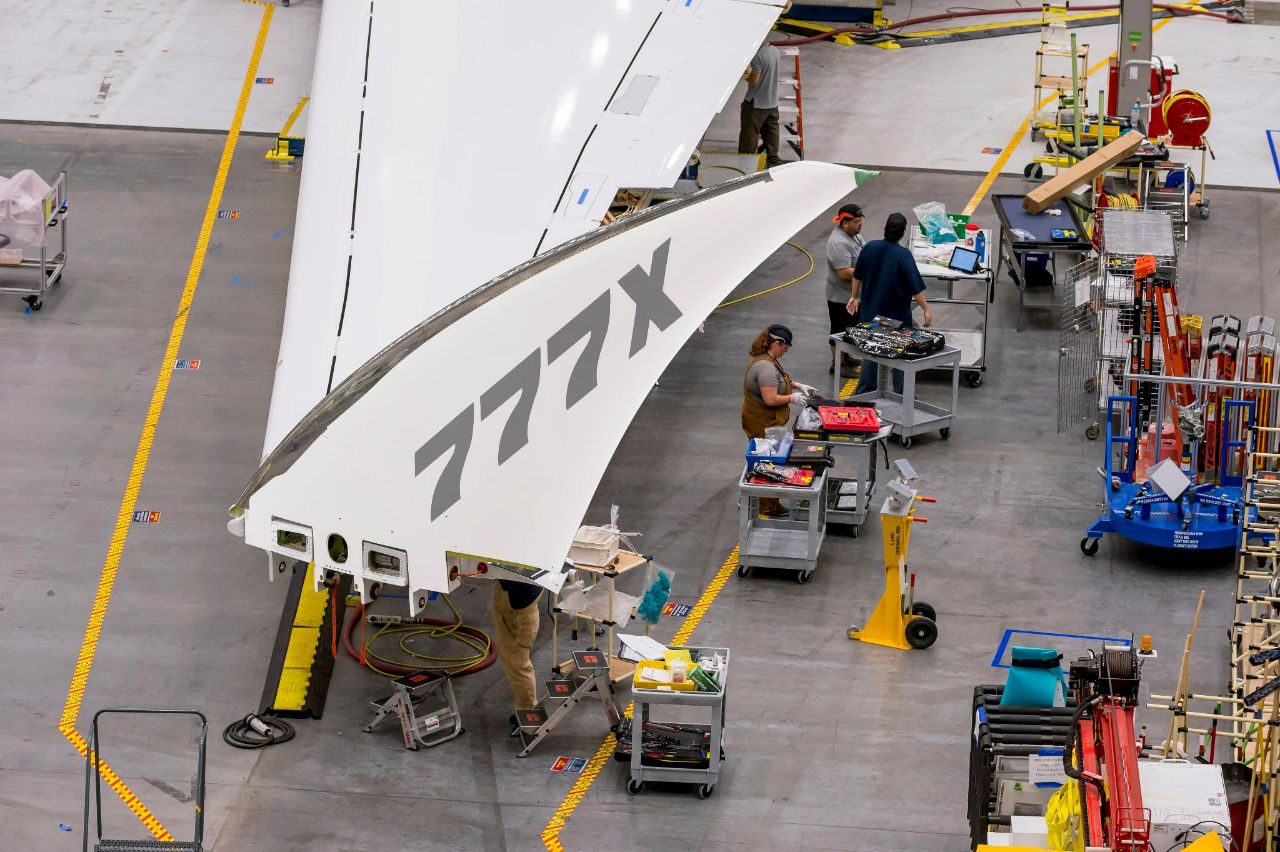
This allows the B777X to have the best of both worlds: longer wings enable more efficient flying, but when folded on the ground make the B777X no wider than the current B777, allowing airports to accommodate it without building special gates (as they had to for the A380).
The engines are a technological marvel too. General Electric designed the new GE9X specifically for the B777X, with each engine offering 134,300 pounds of thrust, a world record for a commercial engine. That’s more thrust than Alan Shepard had at his disposal when he became the first American in space in 1961!
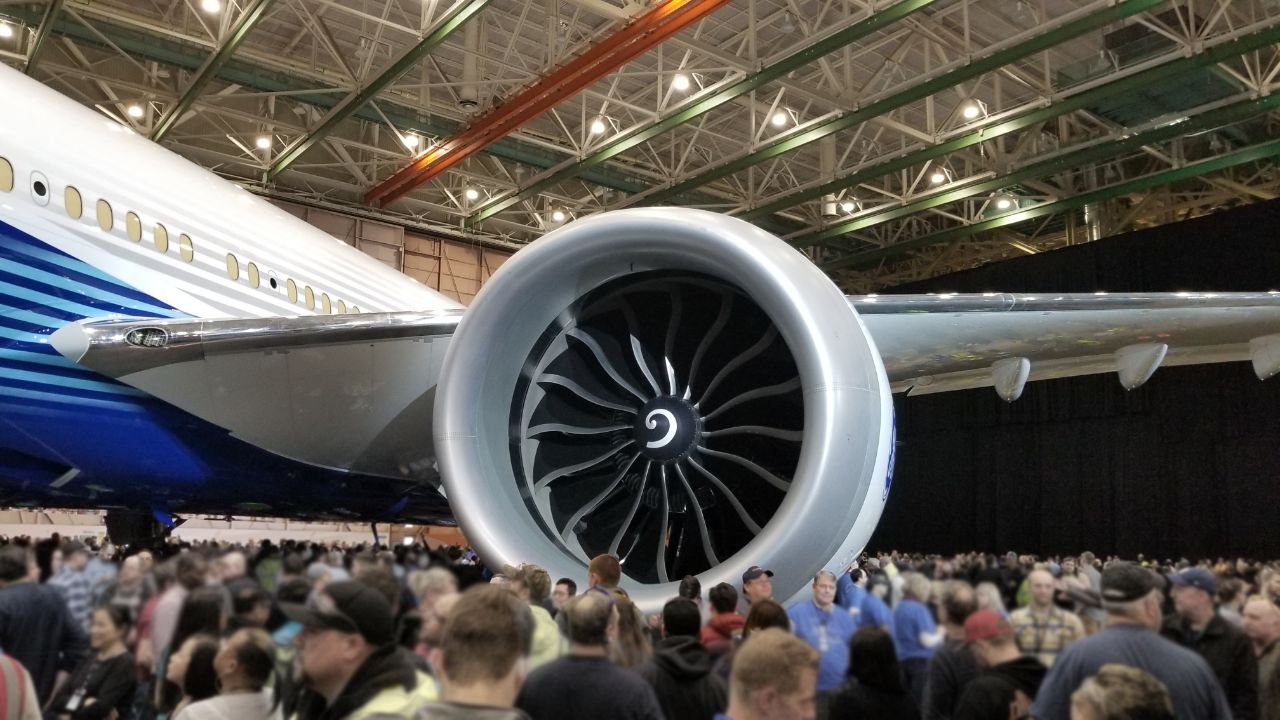
Despite their size, the GE9X is also extremely efficient. Boeing claims that the B777-9 will offer up to 11% lower operating costs than the A350-1000, though those claims can only really be verified once it enters service.
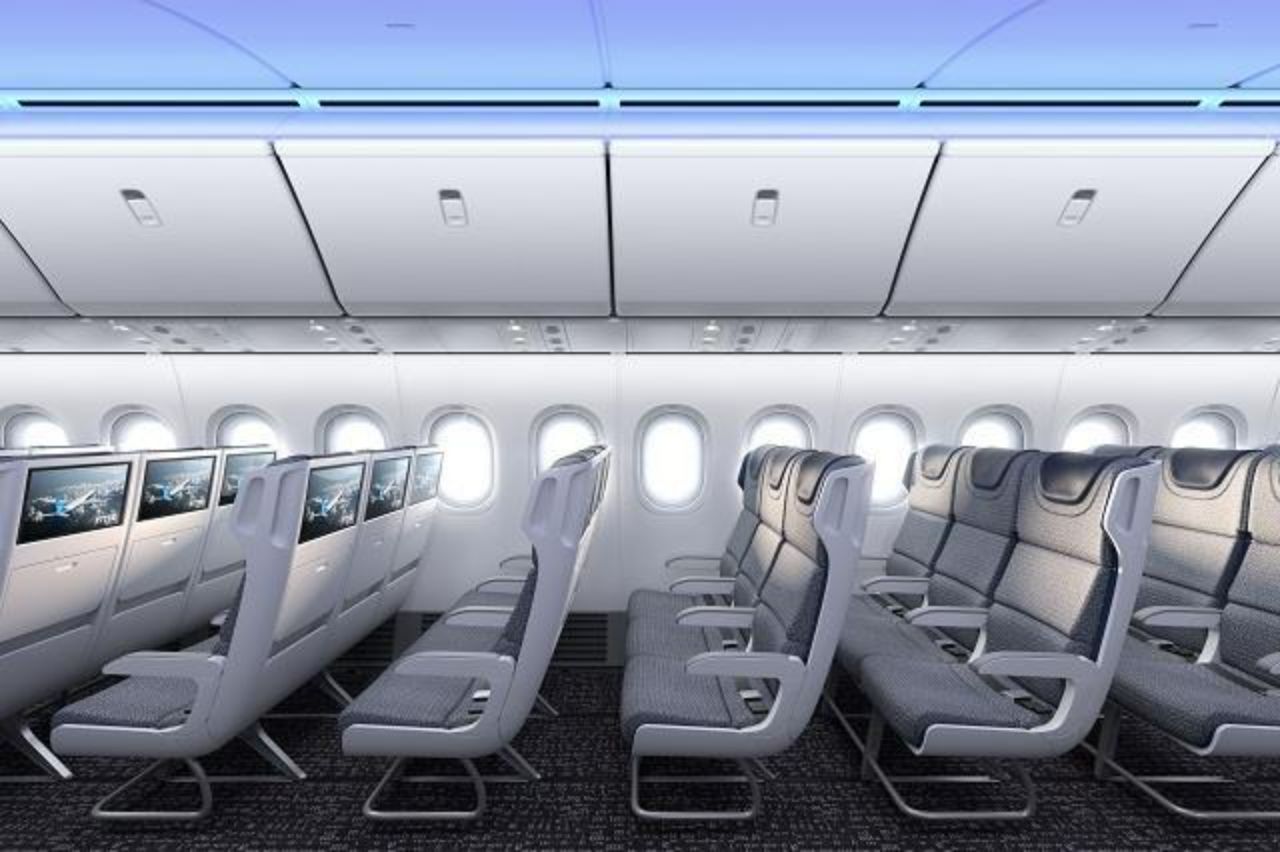
The cabin is four inches wider than the B777, thanks to thinner walls and more efficient insulation. The extra width will not allow existing 10-abreast airlines to add an additional seat, but every inch matters for passenger comfort in Economy and Premium Economy.
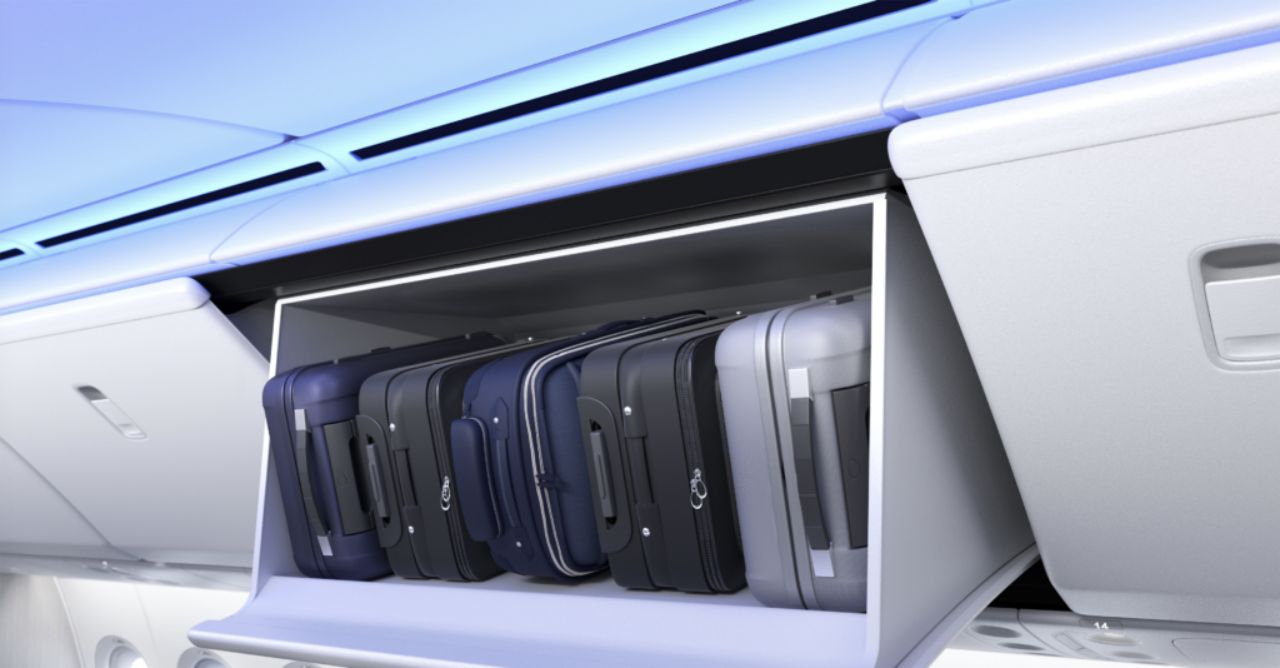
Passengers will enjoy larger overhead bins that allow luggage to be stacked sideways, increasing usable space.
In other quality-of-life improvements, windows will be 16% larger than the B777, using an improved version of the electronic dimmer technology found on the B787 that can block 99.999% of visible light while dimming twice as fast. Electric current is passed through a gel-like substance to control opacity, allowing for shadeless operation.
The B777X’s cabin will also be pressurized to 6,000 feet (instead of the typical 8,000 feet), which means denser air that’s easier to breathe and fewer jetlag effects.
Boeing originally planned to create three variants of the 777X, each designed to counter a specific member of the A350 family.
- The B777-8 would replace the B777-200ER, and compete with the A350-900
- The B777-8LR would replace the B777-200LR, and compete with the A350-900ULR
- The B777-9 would replace the B777-300ER, and compete with the A350-1000
However, it eventually settled on just the -8 and -9, scrapping plans for the -8LR.
| B777-8 | B777-9 | |
| Typical Seat Count (2-class) | 384 pax | 426 pax |
| Range | 16,170 km | 13,500 km |
| Wingspan | 64.82m / 71.75m (on ground/ extended) | |
| Length | 69.79m | 76.72m |
| Height | 19.49m | 19.53m |
| List Price | US$410.2M | US$442.2M |
The B777X programme officially launched at the 2013 Dubai Air Show with 259 orders totalling US$95 billion at list prices, the largest commercial aircraft launch by dollar value.
The B777-9 will be the first to fly, with four prototypes produced to date:
| Registration | First Flight | Testing |
| N779XW | 25 Jan 20 |
|
| N779XX | 30 Apr 20 |
|
| N779XY | 2 Aug 20 |
|
| N779XZ | 20 Sep 20 |
|
N779XW flew from Boeing Field to Singapore (via Moses Lake) for the air show on 5 February 2022, the 16 hour 39 min flight representing the longest international flight the B777-9 has performed to date.
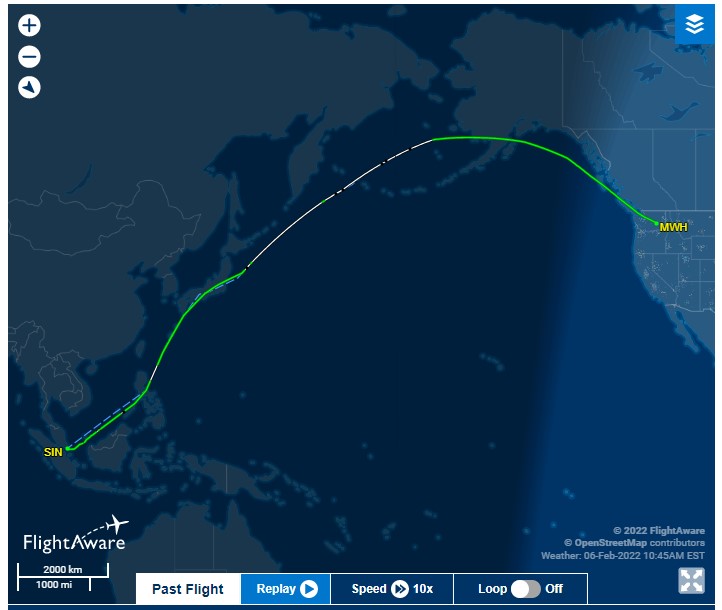
Since then, it’s clocked up a couple of 15-minute test flights out of Changi; those of you living in the East may have seen it performing some maneuvers!
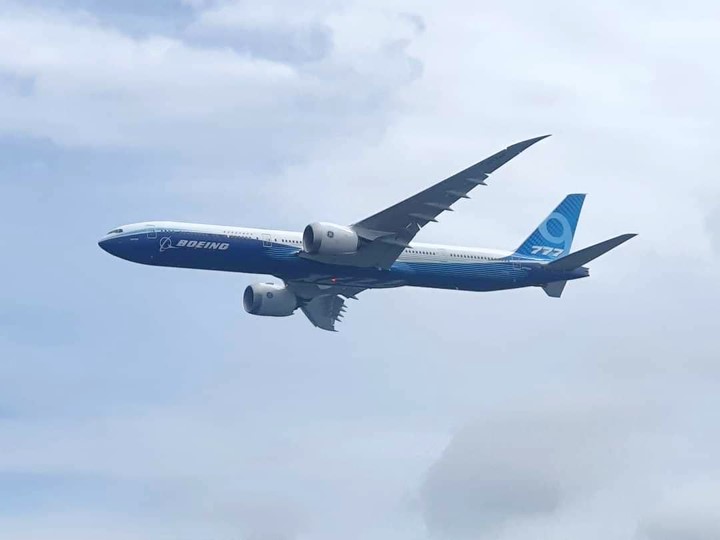
According to Boeing, the B777X order book stands at 334 aircraft across the following customers (though some of these may be cancelled or converted to other models in light of delays).
| Airline | B777X Orders |
| ANA | 20 |
| British Airways | 18 |
| Cathay Pacific | 21 |
| Emirates | 115 |
| Etihad | 25 |
| Lufthansa | 20 |
| Qatar Airways | 74 |
| Singapore Airlines | 31 |
| Unidentified customer(s) | 10 |
| Total | 334 |
Touring the B777X
Singapore marks the second international destination for the B777X, having previously flown to the Dubai Airshow in November 2021
I had a chance to tour N779XW over the weekend, which funnily enough was parked near an Airbus A350XWB, with a Singapore Airlines A380 interposed as a peacemaker.
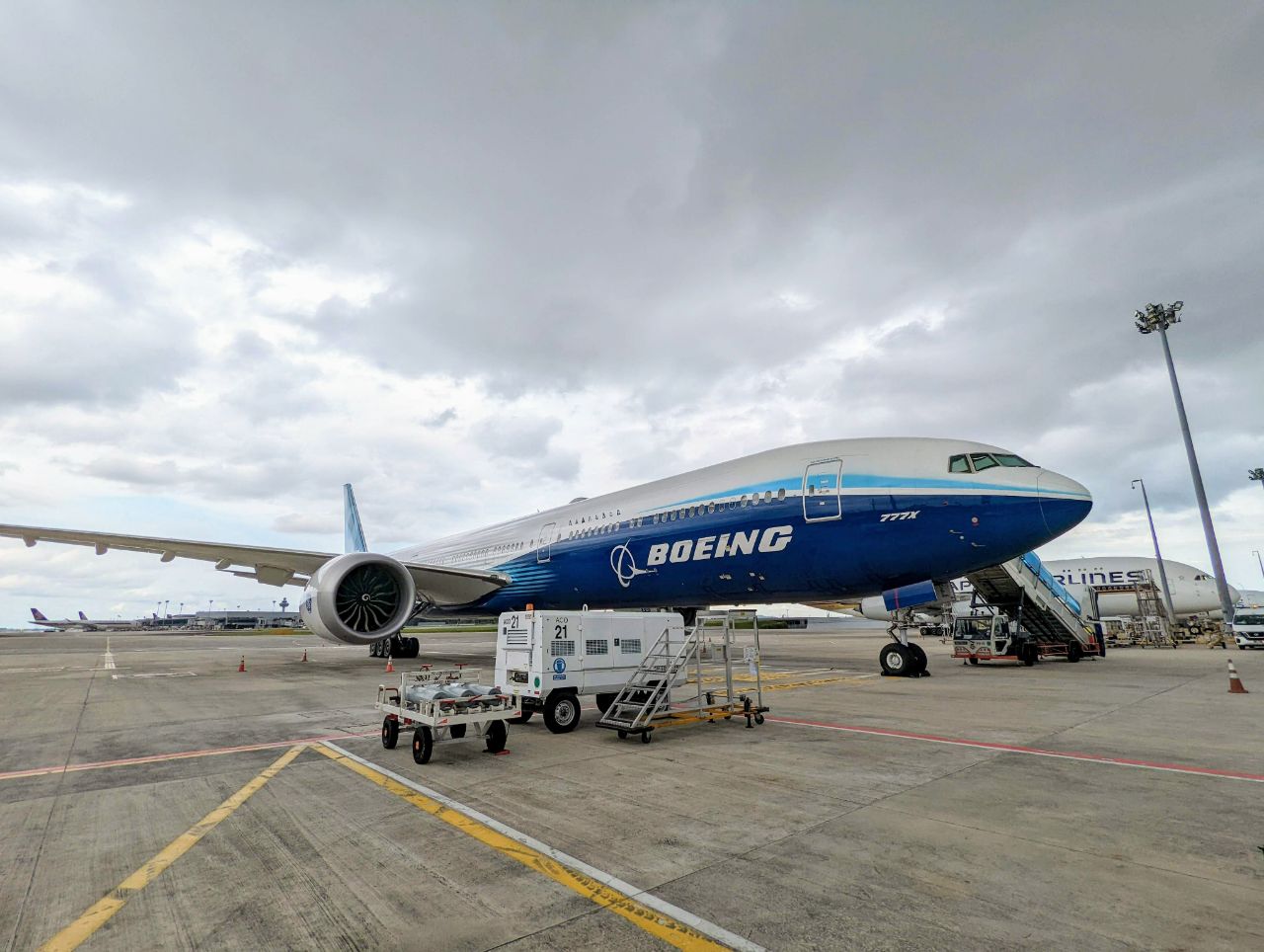
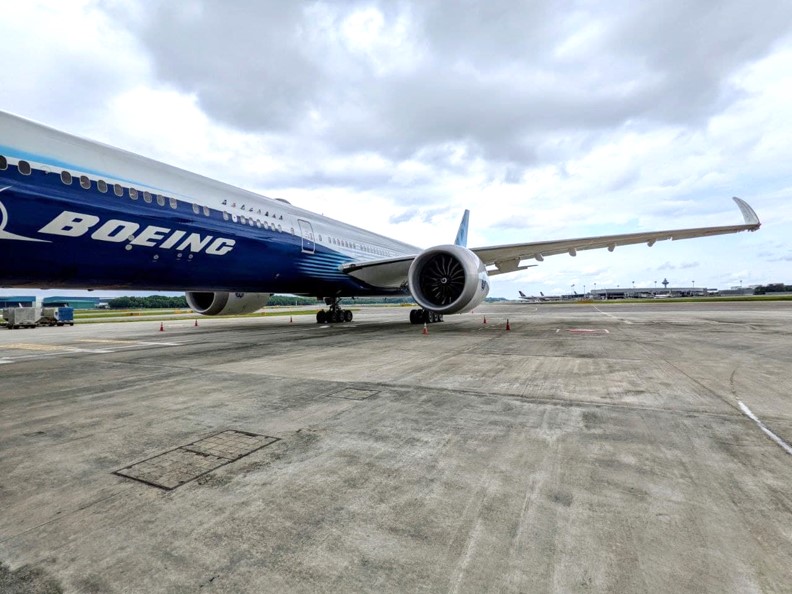
There’s no two ways about it: the B777X is one giant aircraft. That 70m+ wingspan alone would exclude it from some airports, if not for the ingenious folding wingtips. A total of 14 wheels support the airframe, and there’s enough ground clearance to walk underneath it comfortably.
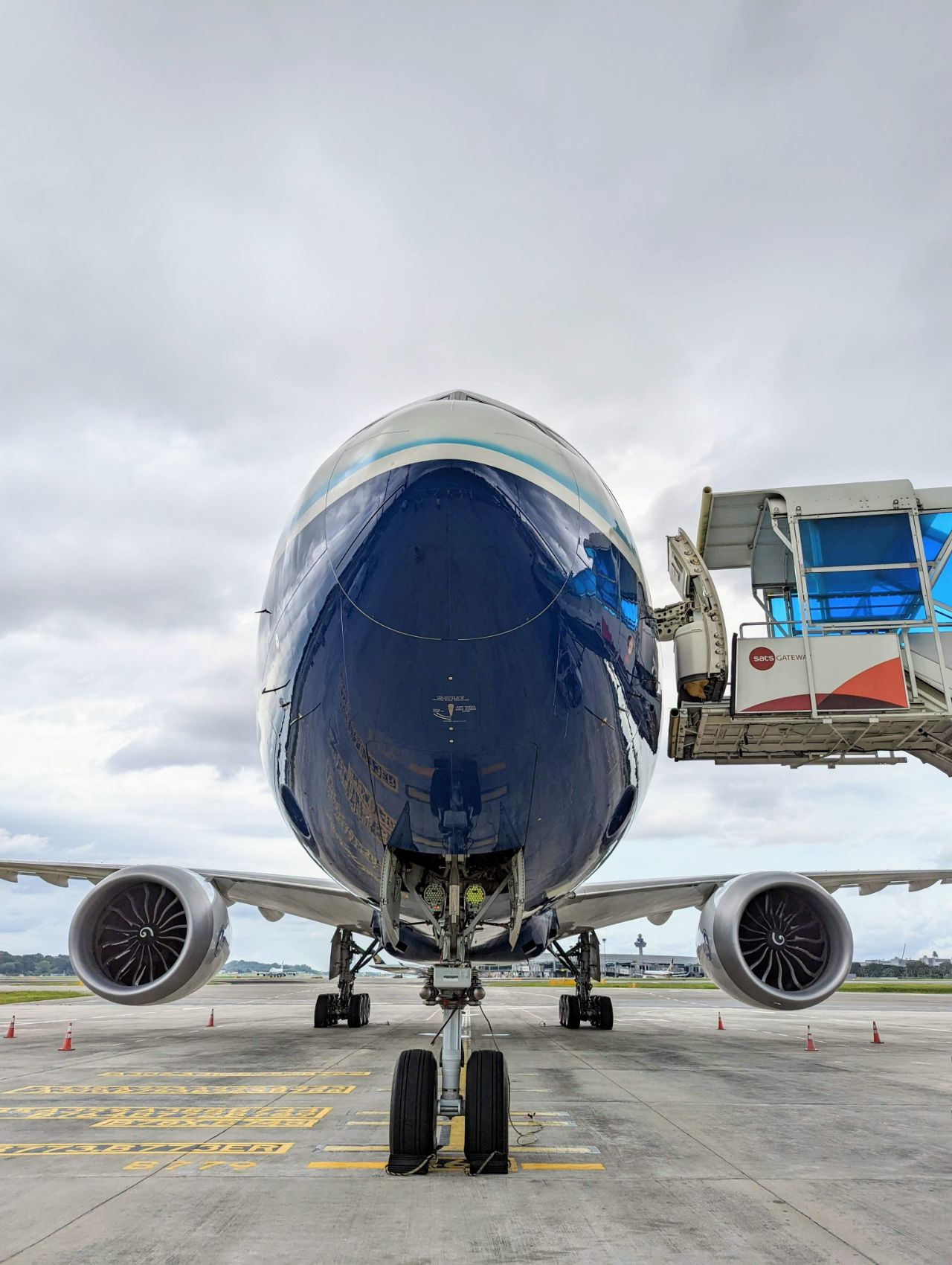
From the top of the tail to the wheels, the aircraft is just shy of 20m tall; for perspective, the A380 is a mere 4m taller. Its engines are so large that an entire Boeing 737 fuselage could just about fit within one of them!

The tails of the eight identified launch customers are tattooed on the side of the fuselage, in reverse alphabetical order.
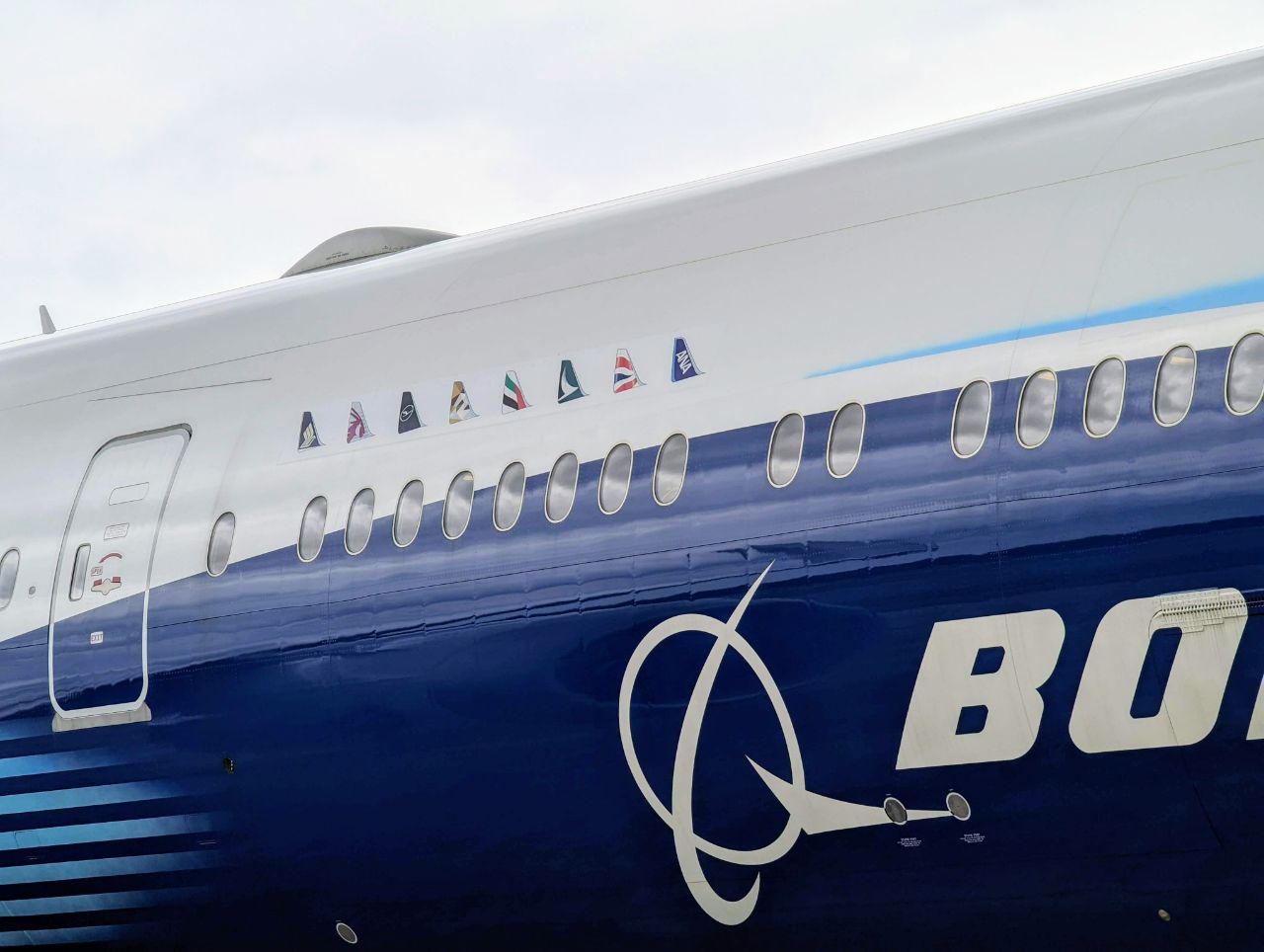
In case you’re wondering, we all had to wear hi-vis jackets for safety on the tarmac, and because the aircraft is considered a production environment- now I know how Alex Cruz feels!

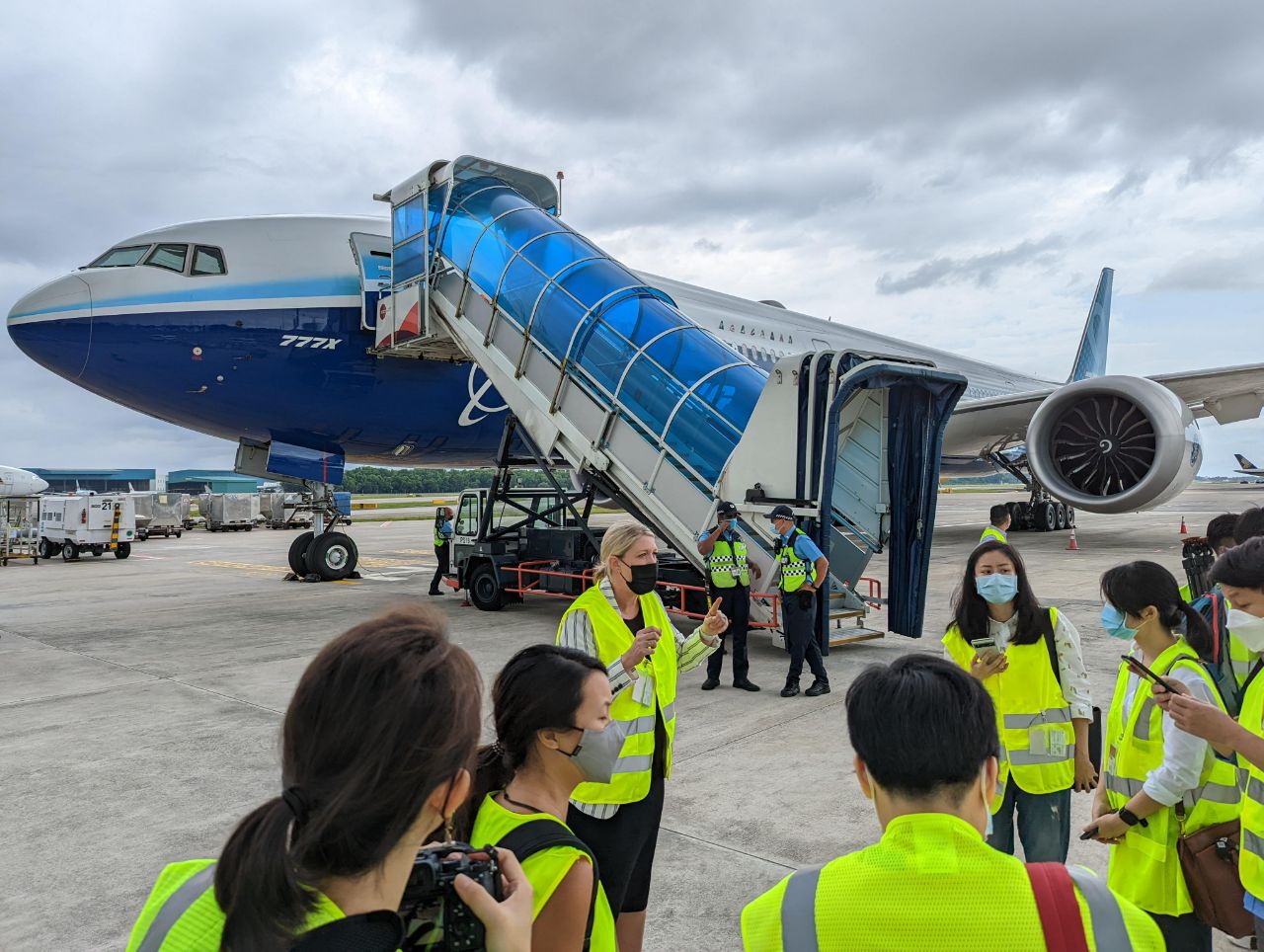
I’ve never been inside a test aircraft before, but as the name suggests, it’s for testing. That means the interior is full of tanks, workstations, and monitoring equipment- like a giant flying laboratory, generating and collecting data about itself.
At the front and aft of the aircraft are 24 x 120 gallon tanks, which use an onboard plumbing system to shuttle water around, changing the weight balance of the plane for various tests. This allows the engineers to see how the aircraft responds to shifts in the centre of gravity, and what the optimal loading looks like.
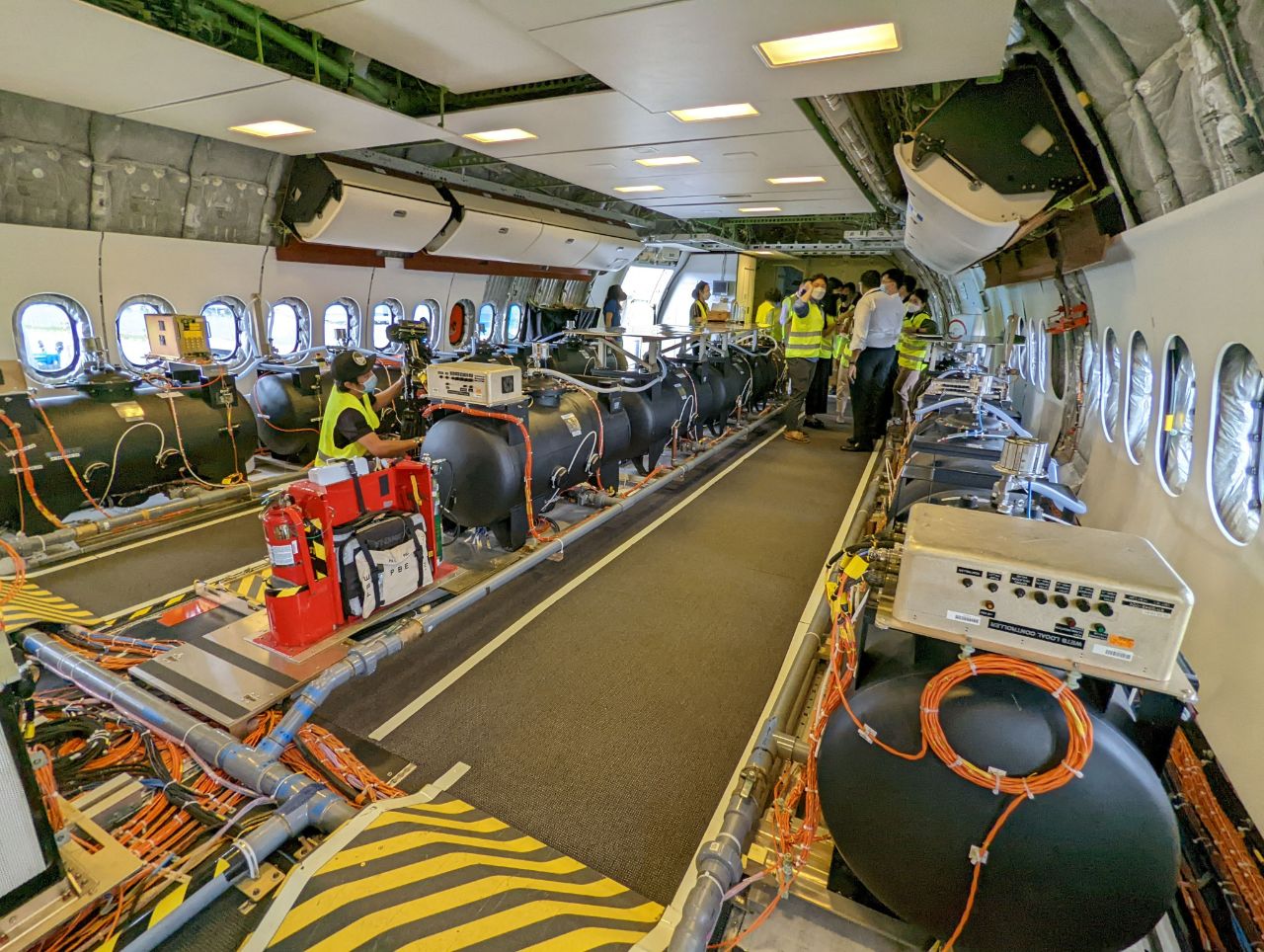
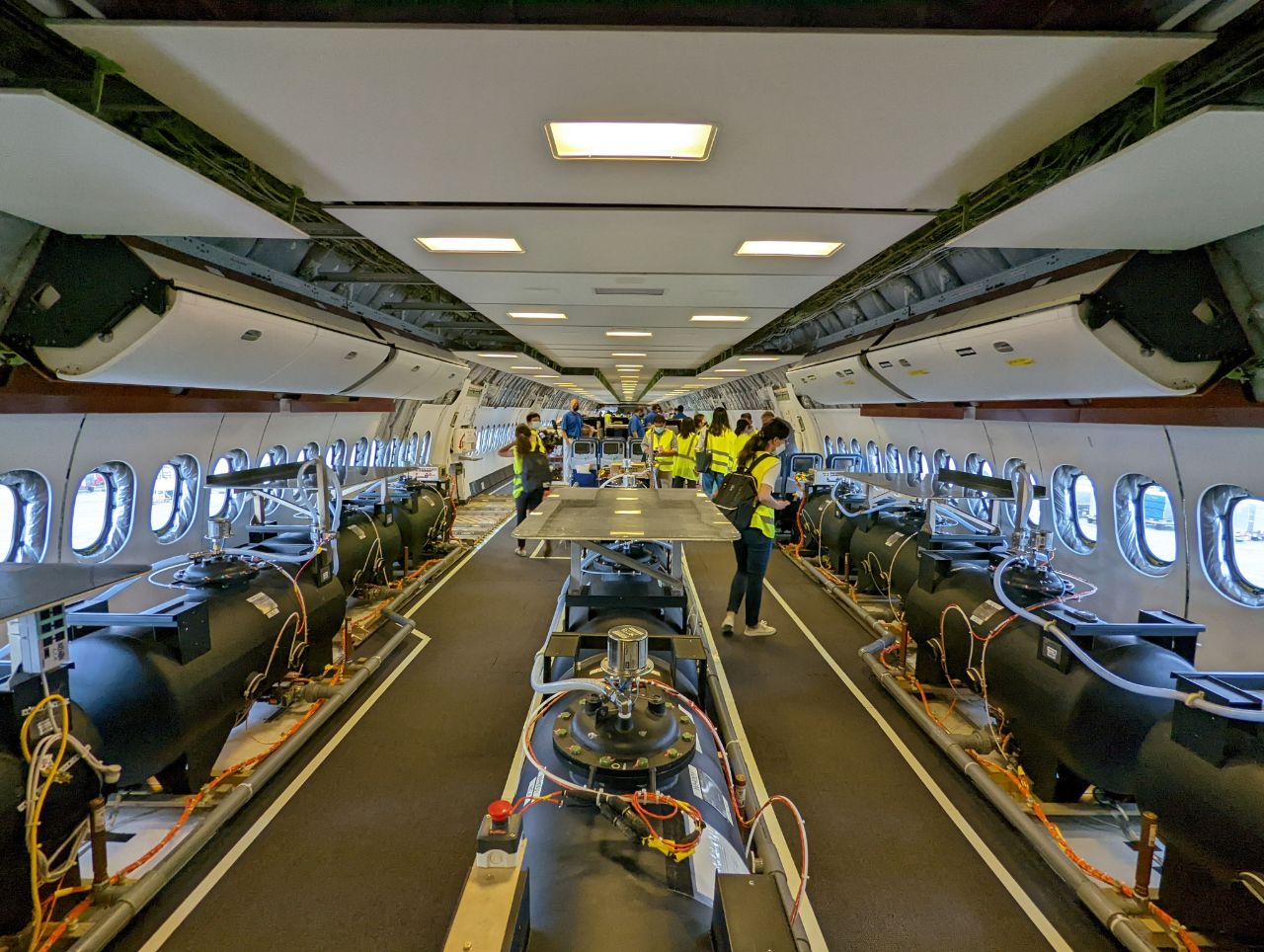
There’s also an entire suite of monitoring equipment for the flight engineers to track the innumerable data points generated from a test flight- everything from cabin pressure to noise production is recorded for analysis. Those white bags with the red straps you see are life vests, and the green tanks are oxygen canisters. This is an operational aircraft, after all, and has to be compliant with basic safety measures.
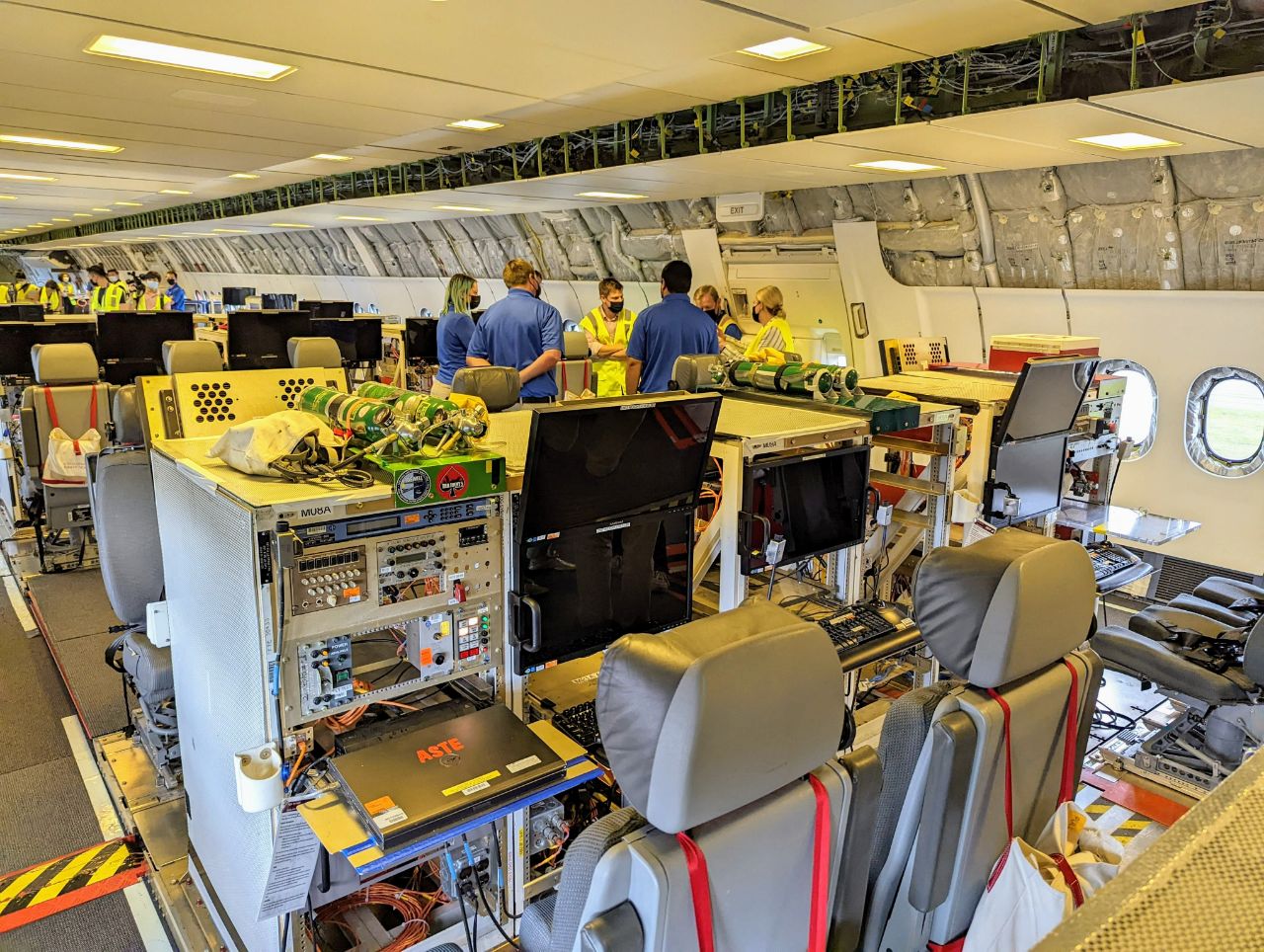
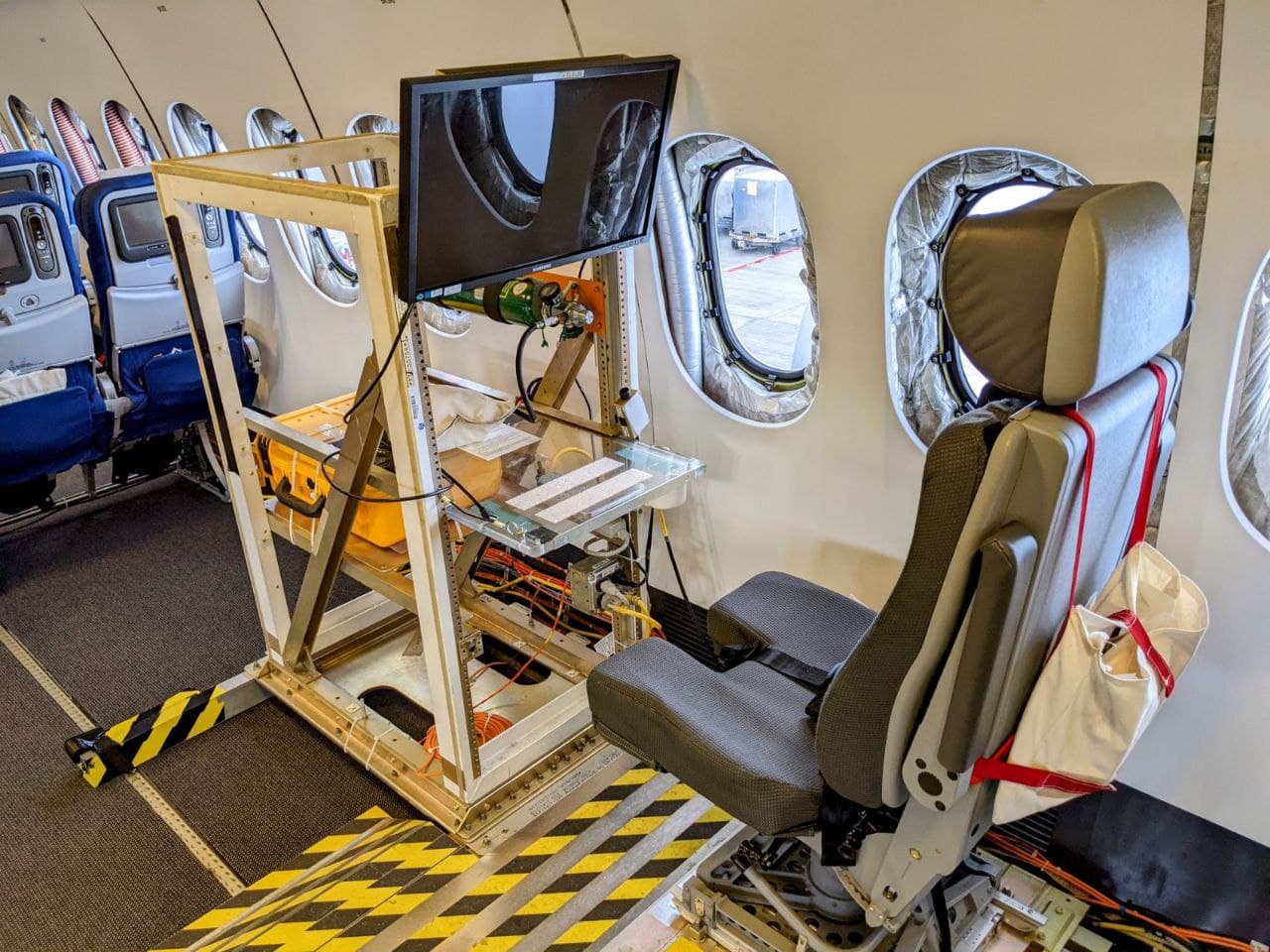
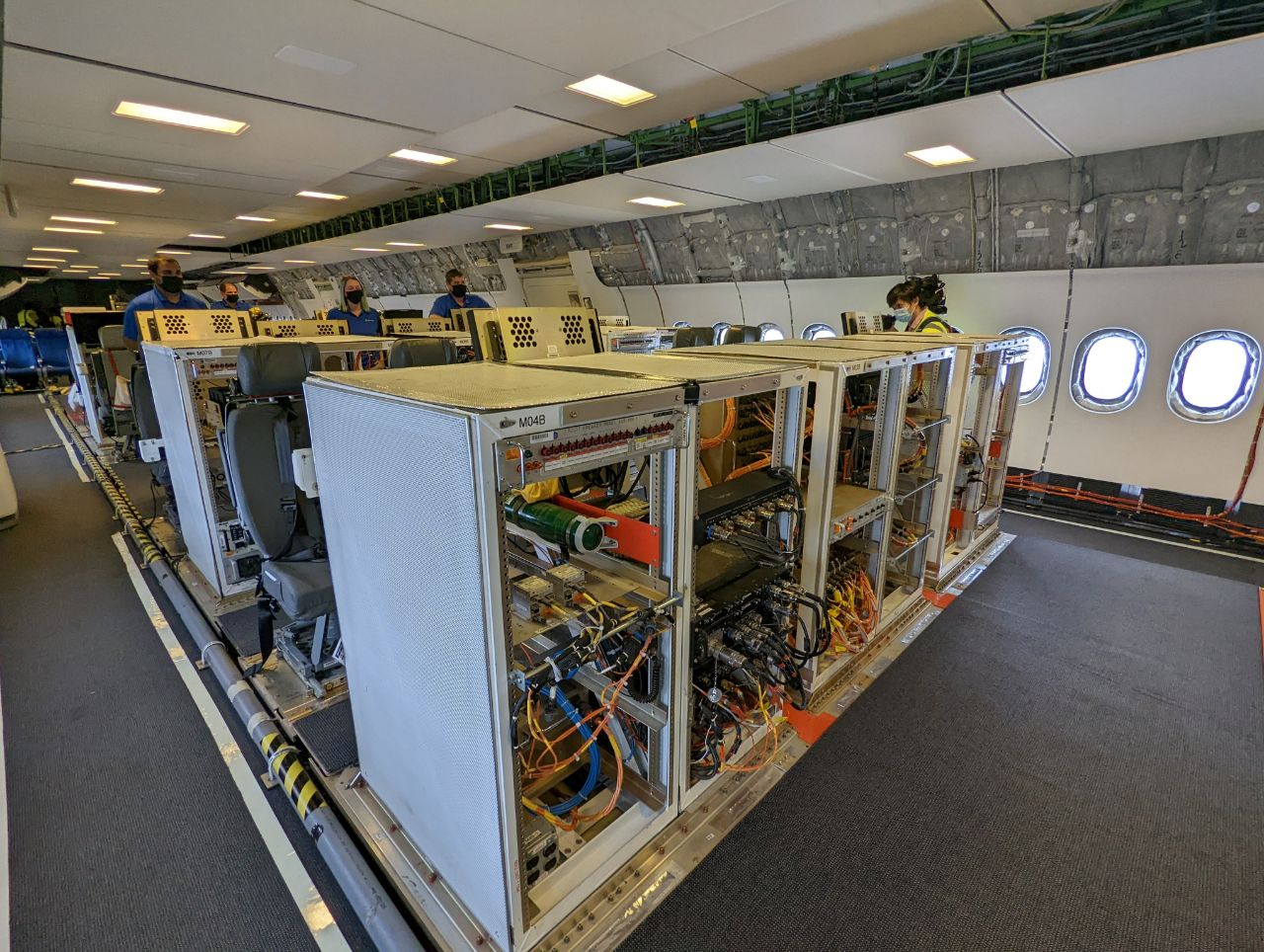
They aren’t kidding about this being an experimental aircraft. In some places, the side panels haven’t even been installed, allowing you to see the insulation that normally lines the walls. These windows are slightly higher than those on the B777, giving passengers an improved view.
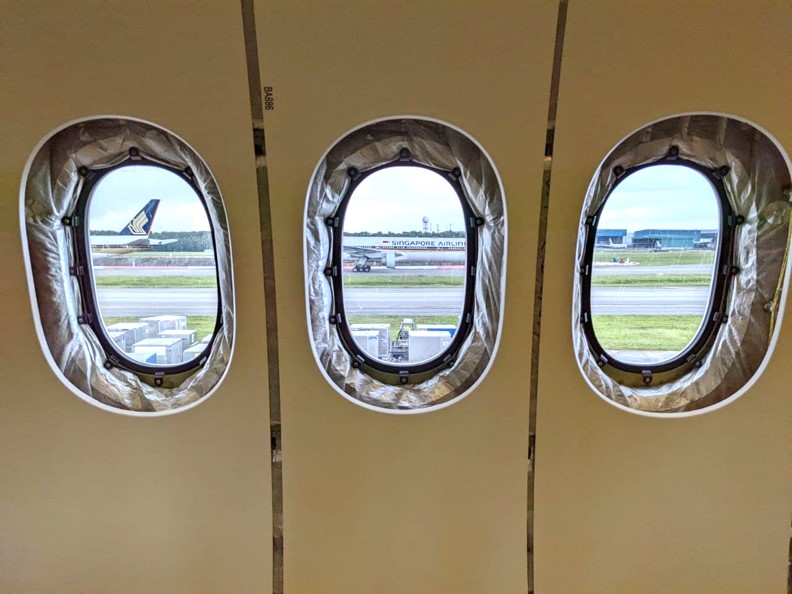
This curious hamster wheel-looking thing at the rear of the cabin helps measure static pressure. A transparent tube funnels a nylon cable into a hole in the ceiling, attached to a shuttlecock that floats behind the plane. This enables accurate measurements of the plane’s exact airspeed and altitude, and hence the calibration of sensors.
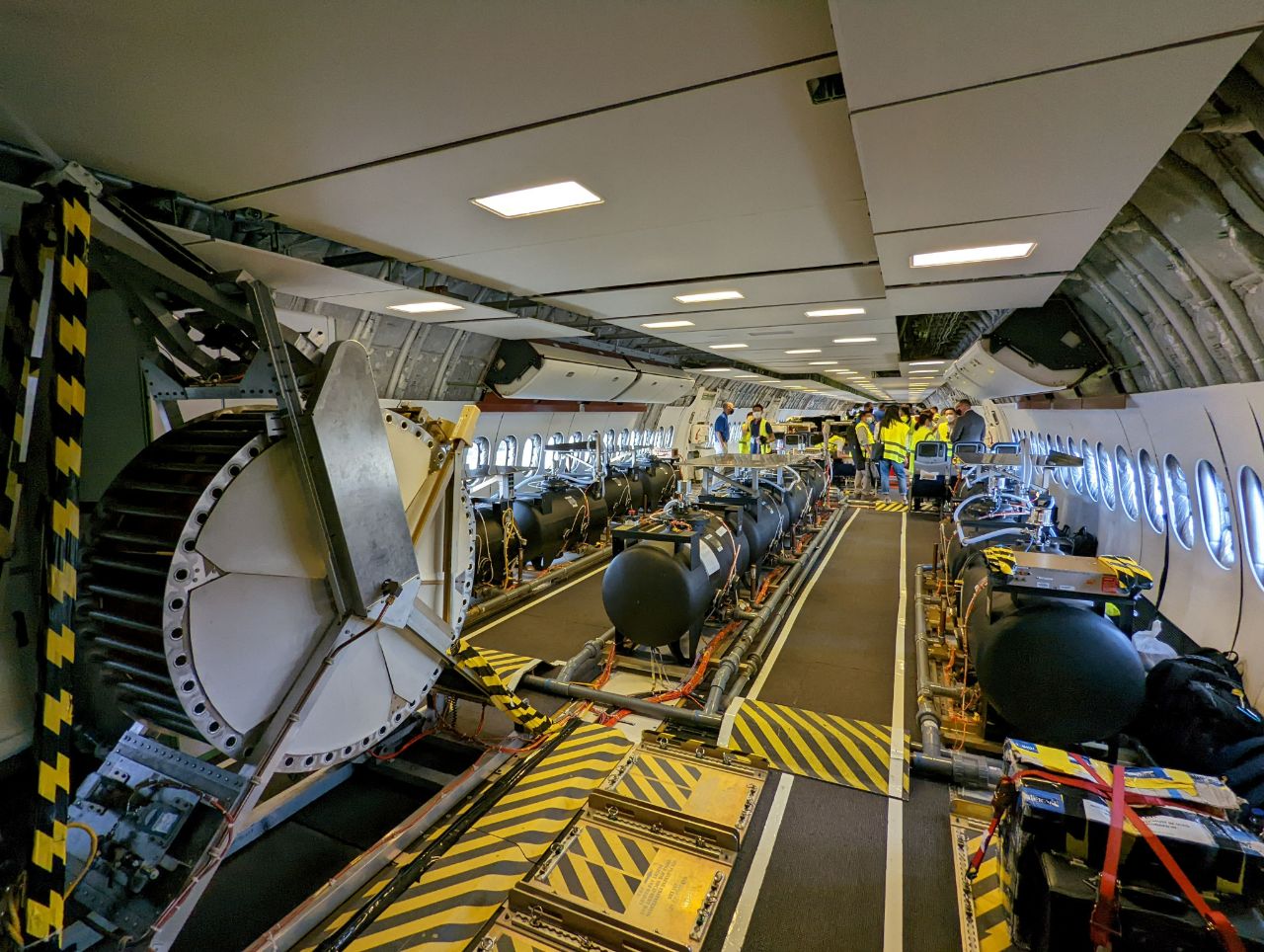
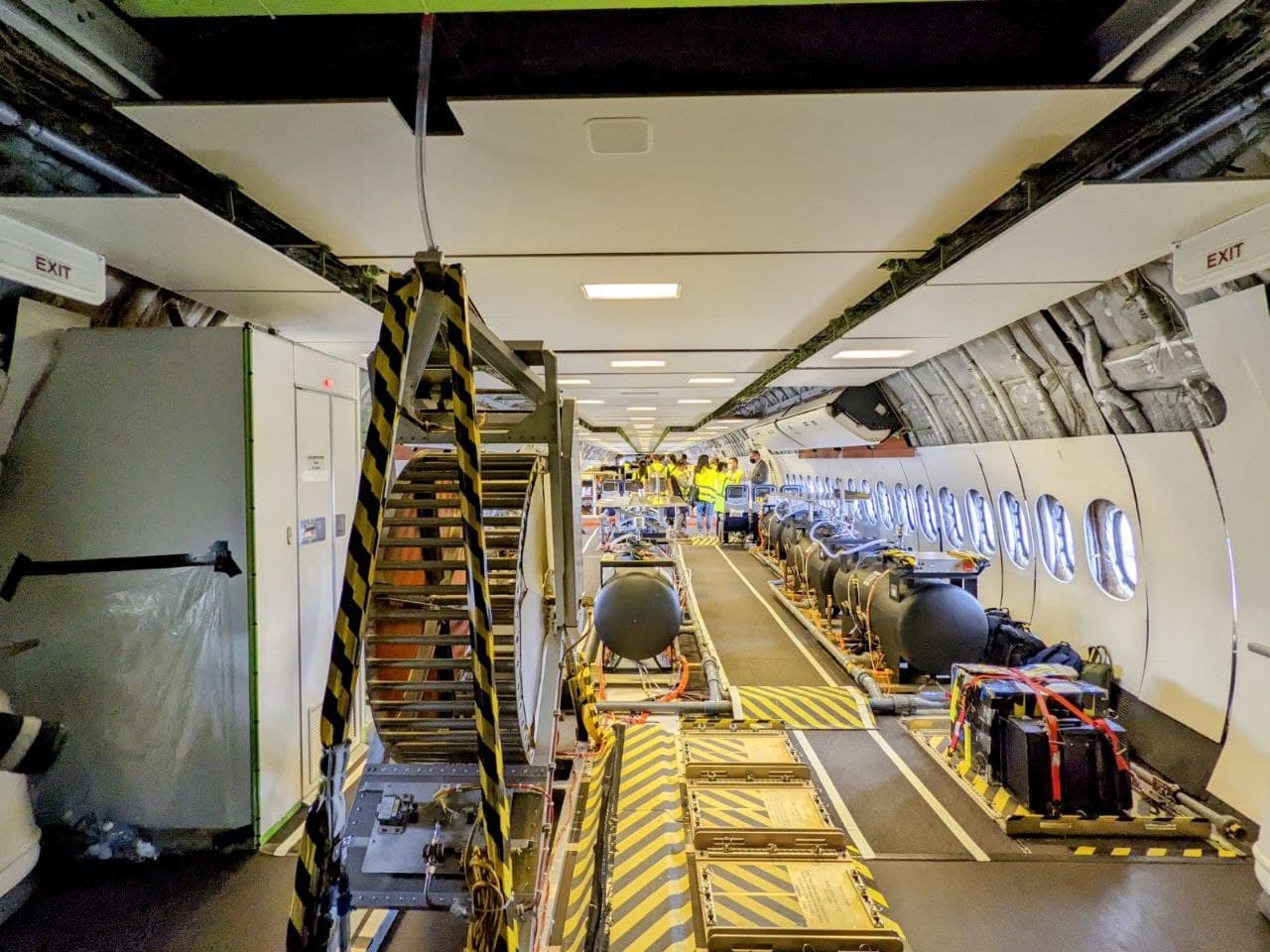
There was an interview going on in the cockpit so I couldn’t pop my head in for a picture, but as this one from the Dubai Airshow illustrates, it’s a screen-heavy avionics suite just like the B787 with three seats and heads up displays. There’s also a special knob for controlling the position of the folding wingtips on the ground- it takes 20 seconds to lower the wingtips fully. Can’t wait for this to get added to Microsoft Flight Simulator…
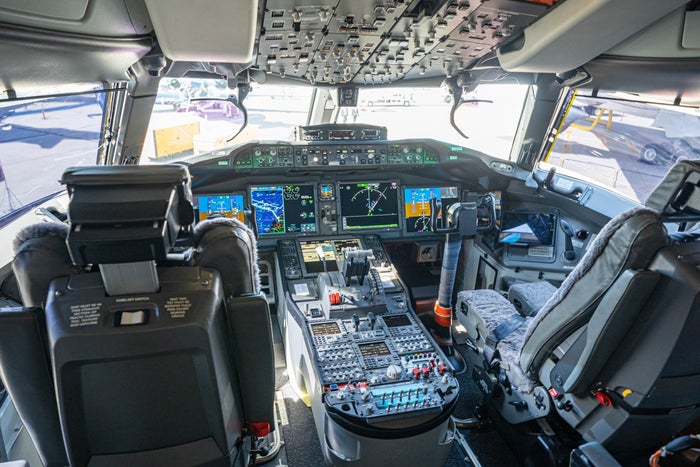
You could argue that the interior of the B777X only feels massive since it’s missing the overhead bins, the passenger seats, the galleys and walls that will eventually be installed. Granted, but even so I do believe you’ll find this among the most spacious twin-engined cabins you’ve ever seen.
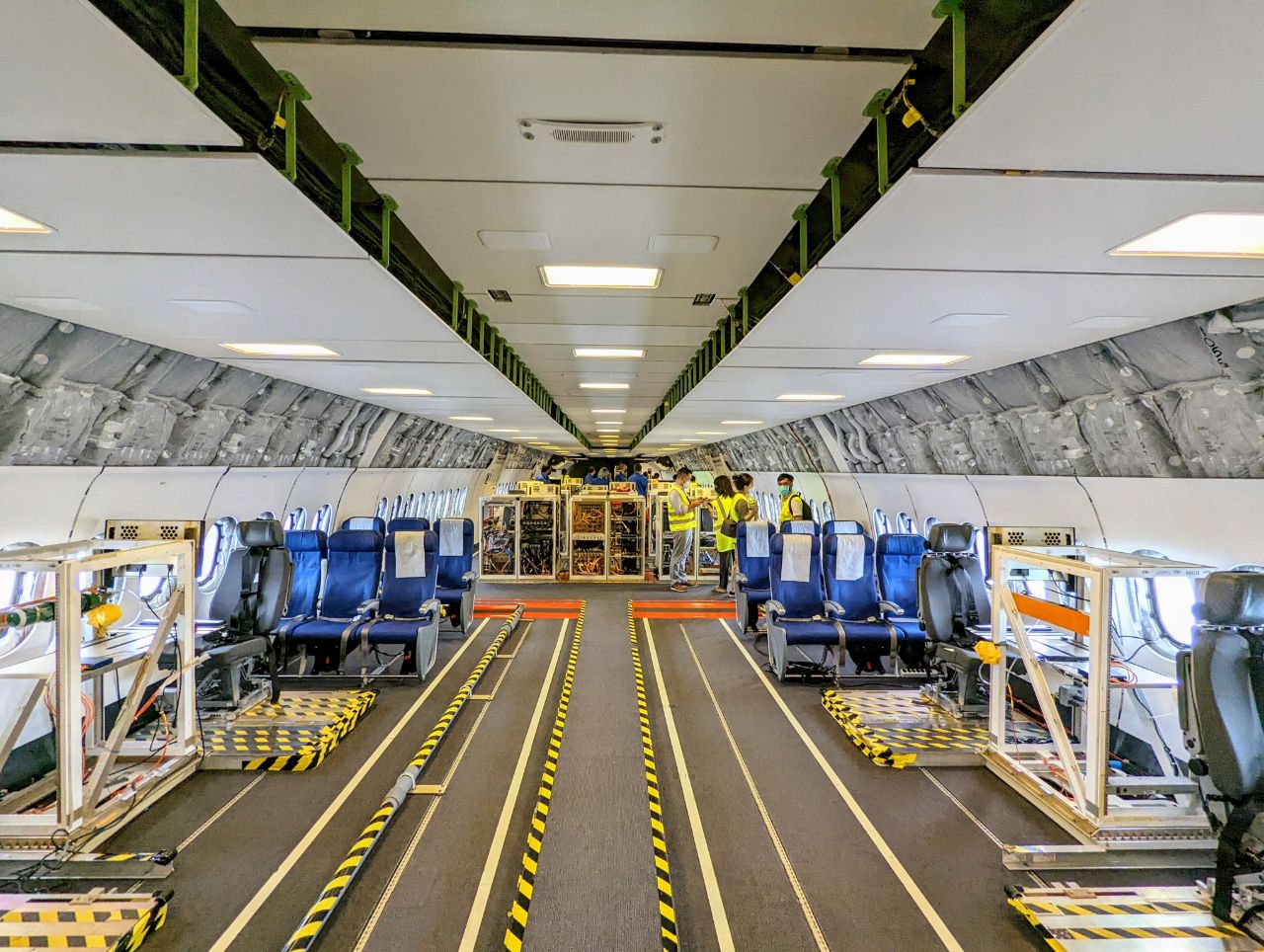
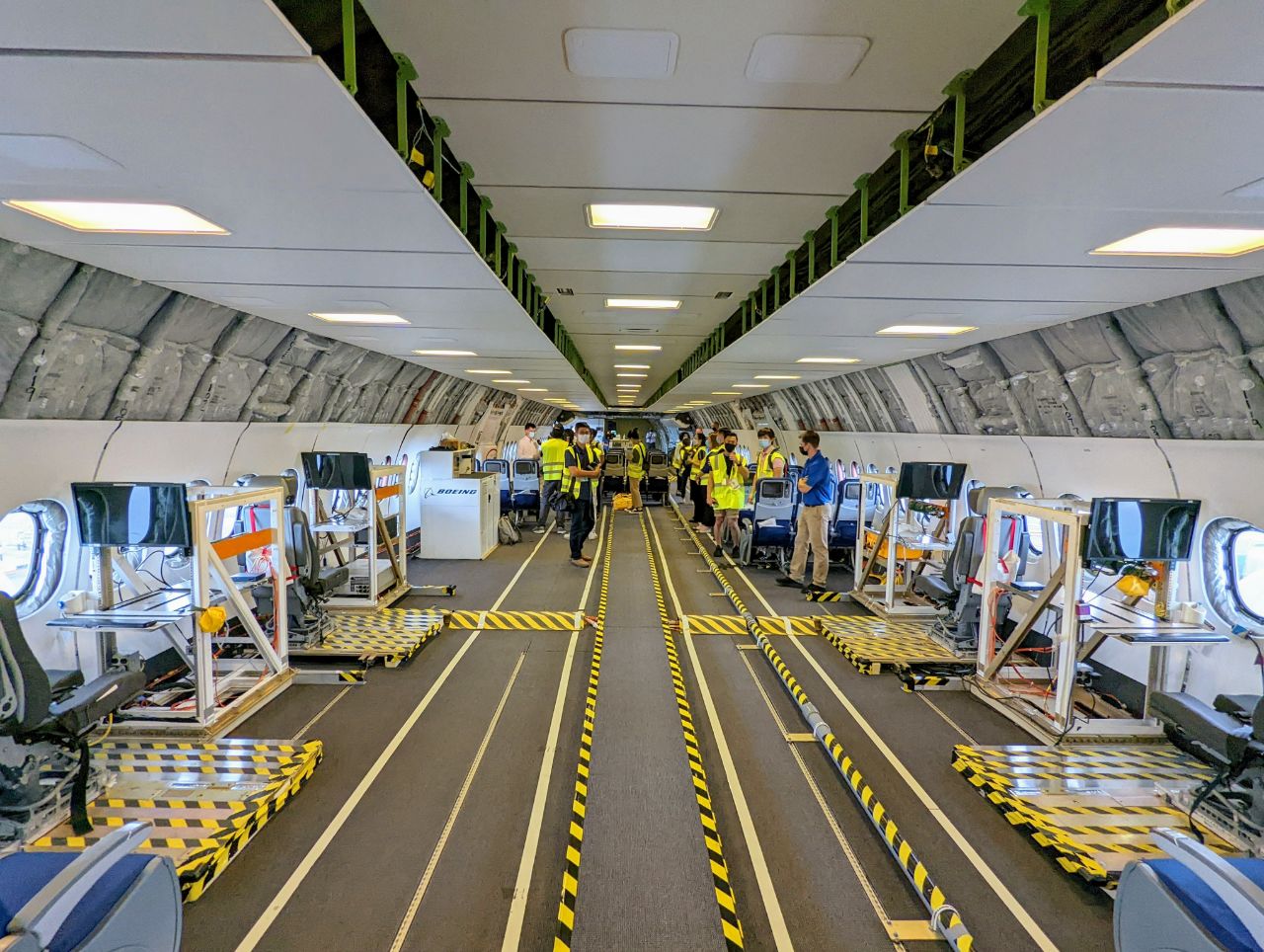
N779XW may be a test aircraft, but the Boeing crew still need somewhere to sit while in transit. Seating comes in the form of four rows of Economy Class seats, with some pretty generous legroom!
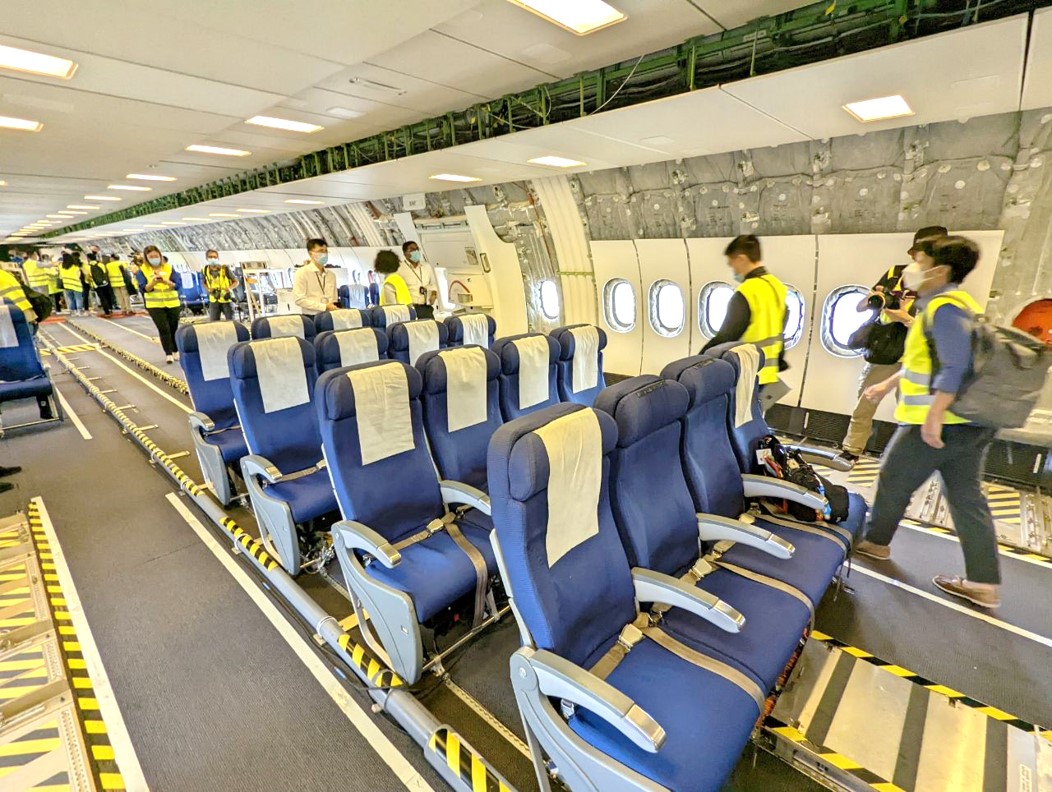
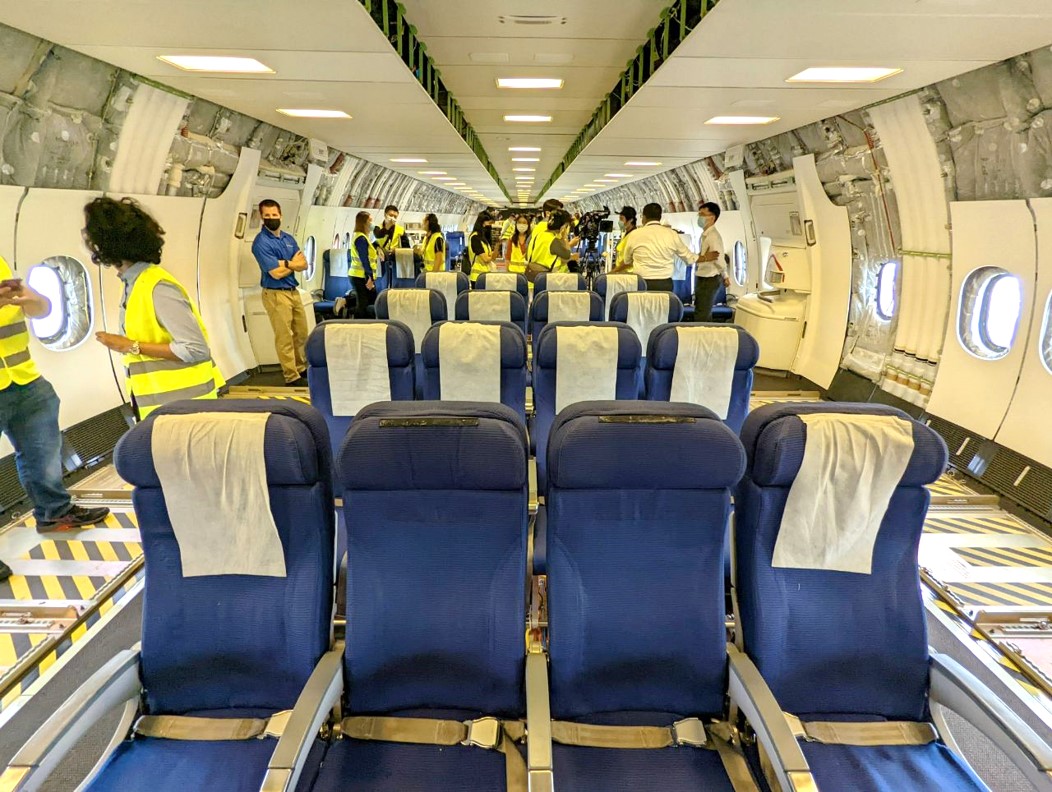
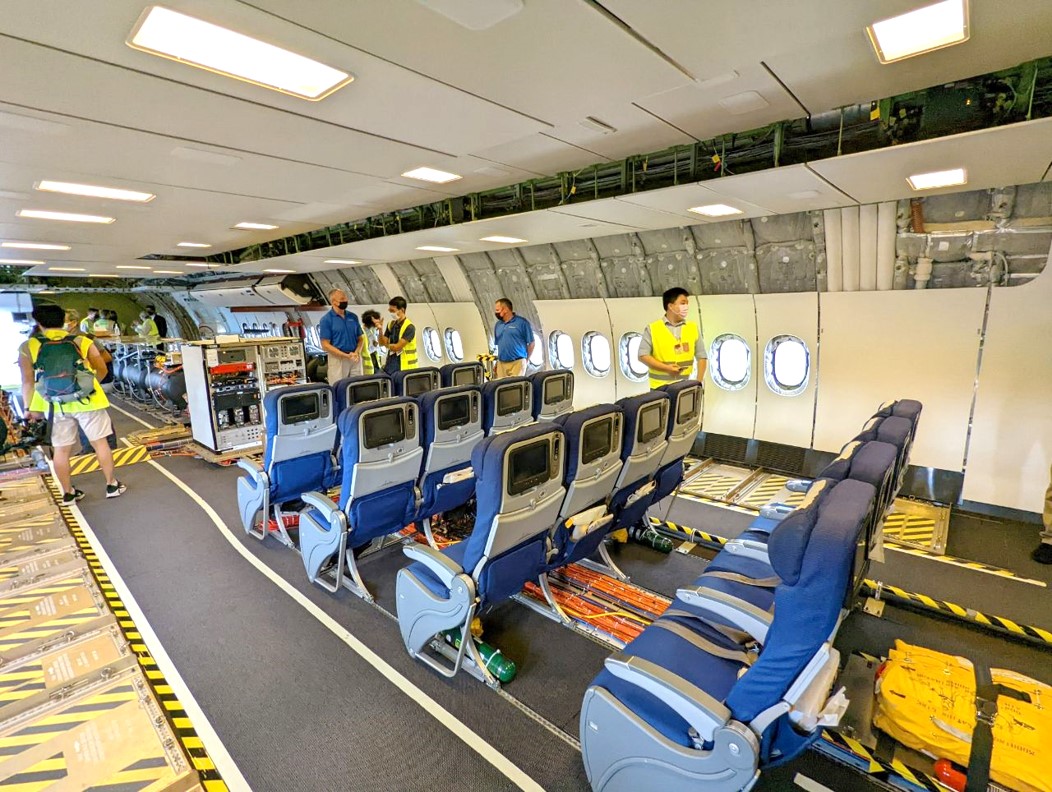
You might recognise these seats if you’ve flown with KLM, because Boeing purchased them off of a decommissioned plane. And before you ask, no, the IFE system isn’t operational. On the 16.5 hour flight over to Singapore, passengers had to make do with BYOD entertainment. At least the 4-across configuration provides a flat surface for sleeping…
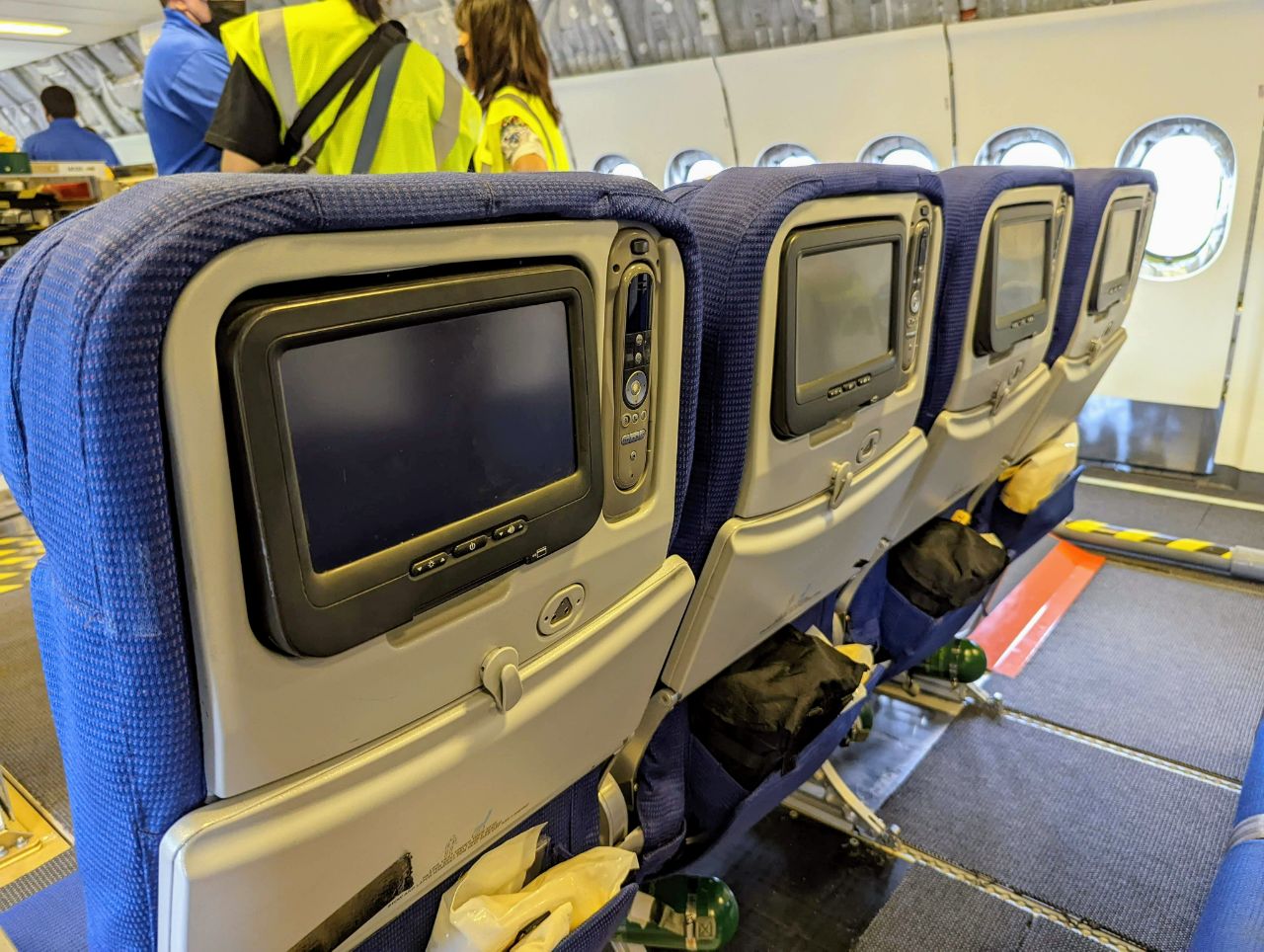
Speaking of cabin products, the Singapore Airlines team was out in full force during the tour, with their Vice President for Product Innovation sharing some (deliberately vague) thoughts about the new cabin products it intends to install on its 31 B777-9s, which will replace the B777-300ERs in its fleet.
I’ll cover this in a separate article, suffice to say that Singapore Airlines is not alone in its plans to use the B777X as the platform for its flagship products:
- Cathay Pacific will introduce a new First and Business Class on the B777X
- Emirates will install its latest First Class on the B777X, which is currently only available on a handful of B777-300ERs (the proposed Business Class on the B777X, however, is nothing to get excited about)
- Lufthansa will introduce its awesome, award winning, top-of-the-line, life-changing, revolutionary and totally radical Business Class product on the B777X. Yes, the same conceptual product that earned it a 5-Star rating with Skytrax…
So even if you’re not into all this avgeekery, there’s reason enough to be excited about this new aircraft.
Conclusion
While there’s still significant work to be done before a B777X lands up in the hands of a customer, the type has now racked up around 2,000 flight testing hours- just over half the approximate 3,500 flight hours the B777 and B787 underwent before receiving FAA certification. Given the greater scrutiny the company is under, it’s entirely possible they’ll need to clock more than that, but Boeing is very much committed to seeing the programme through.
It’s unlikely you’ll set foot on a B777X for at least a couple more years, but what a milestone for aviation it’ll be when that happens.
What are you looking forward to with the B777X?




Looks nice but after seeing Boeing’s innovation capabilities lead to the deaths of hundreds of innocent travellers, I’ll be giving this one a miss for as long as possible.
Safety first.
Creating wealth later.FAA and Boeing our only Aviation priority is to prevent collision in all aspects of flight.